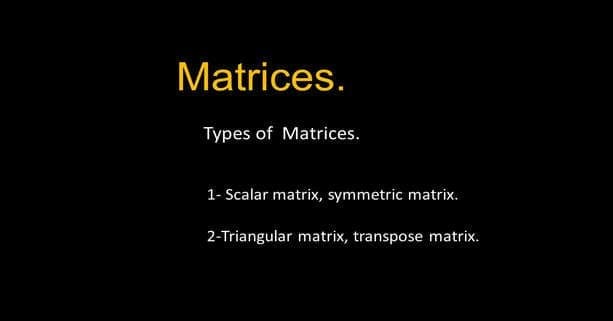Types of matrices-part 2.
Scalar matrix, Symmetric matrix.
The scalar matrix, the first item of the types of matrices, is the matrix, where the diagonal is a scalar for the given matrix, the diagonal is =2, while the remaining elements are all zeros.
The second item of the types of matrices, is the symmetric matrix a matrix, from its name, is a matrix that is symmetrical about the diagonal.
For every i,j aji=aij, for an element above the diagonal a22, we have a12=-3, which is equal to the element to the left of a22, which is a21, with no change of signs. Similarly a23=a32=+7
So we will find that aij=aji, a21=a12, and a23=a32, a21=-3, which is the element in the second row, with the first column.
While a12=-3, which is the first row, with the second column. a23=7=a32, which is this element, the third row with the second column. What is the unit matrix? The unit matrix is the third item of the types of matrices, it is a matrix, for all diagonal elements=0.


While the other remaining elements are zeros.
What is the skew-symmetric matrix? it is the matrix, for which aij =-aji. So for a21=-a12, a23=-a32.
What is the triangular matrix?
The 4rth item of the types of matrices is the Triangular Matrix or the echelon form. The matrix consists of one of two forms, the first form is the upper triangular matrix or a lower triangular matrix. The main difference can be shown as follows.
For the given matrix, we have a matrix 3×3, the elements of the diagonal are 1,4,6. The elements above the diagonal are 3,2,1. While the elements below the diagonal elements are all zeros. The other form is the lower matrix.
The lower matrix has elements of zero values above the diagonal elements, while other elements below the diagonal have values. The expression for the lower matrix can be written as aij for i> or= j, which means that in this case, aij has a value.
While aij=0 for i<j. For instance, a23 or the second row with the third column, for which i, or the row number is < j which is the column number.
When the row number i is > =the column number j. For instance, elements, a31,a32, and a33 will have values.
The upper matrix has a definition that is opposite to the definition of the lower matrix.
The second-row elements are (7,6,8). While the third-row elements are(2,3,6). For the transpose matrix, we let the rows change to columns and change the columns to rows.
This is the first column, which will be the first row and will be (2,7,2), as we can see, the second row will be (5,6,3). The third column will be the third row, for which the values are (4,8,6).


For a useful external link, math is fun for the matrix part.
The next post, Matrix operation-part-1. the post includes the addition and subtraction of two matrices, the scalar product

